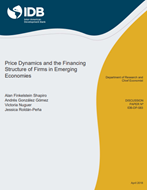Price Dynamics and the Financing Structure of Firms in Emerging Economies
Date
Apr 2018
We use a novel dataset that merges goods-level prices underlying the CPI in Mexico with the balance sheet information of Mexican publicly listed firms and study the connection between firms' financing structure and price dynamics in an emerging economy. First, we find that larger firms (in terms of sales and employees) tend to use more interfirm trade credit relative to bank credit. Second, these firms use interfirm trade credit as a mechanism to smooth variations in their prices. Third, all else equal, firms with a higher trade-to-bank credit ratio tend to lower prices. In turn, the behavior of these firms explains the negative relationship between aggregate trade credit growthand inflation in the data. A tractable New Keynesian model with search frictions in physical input markets sheds light on firms' structural characteristics as well as the economic mechanisms that rationalize our empirical findings.



